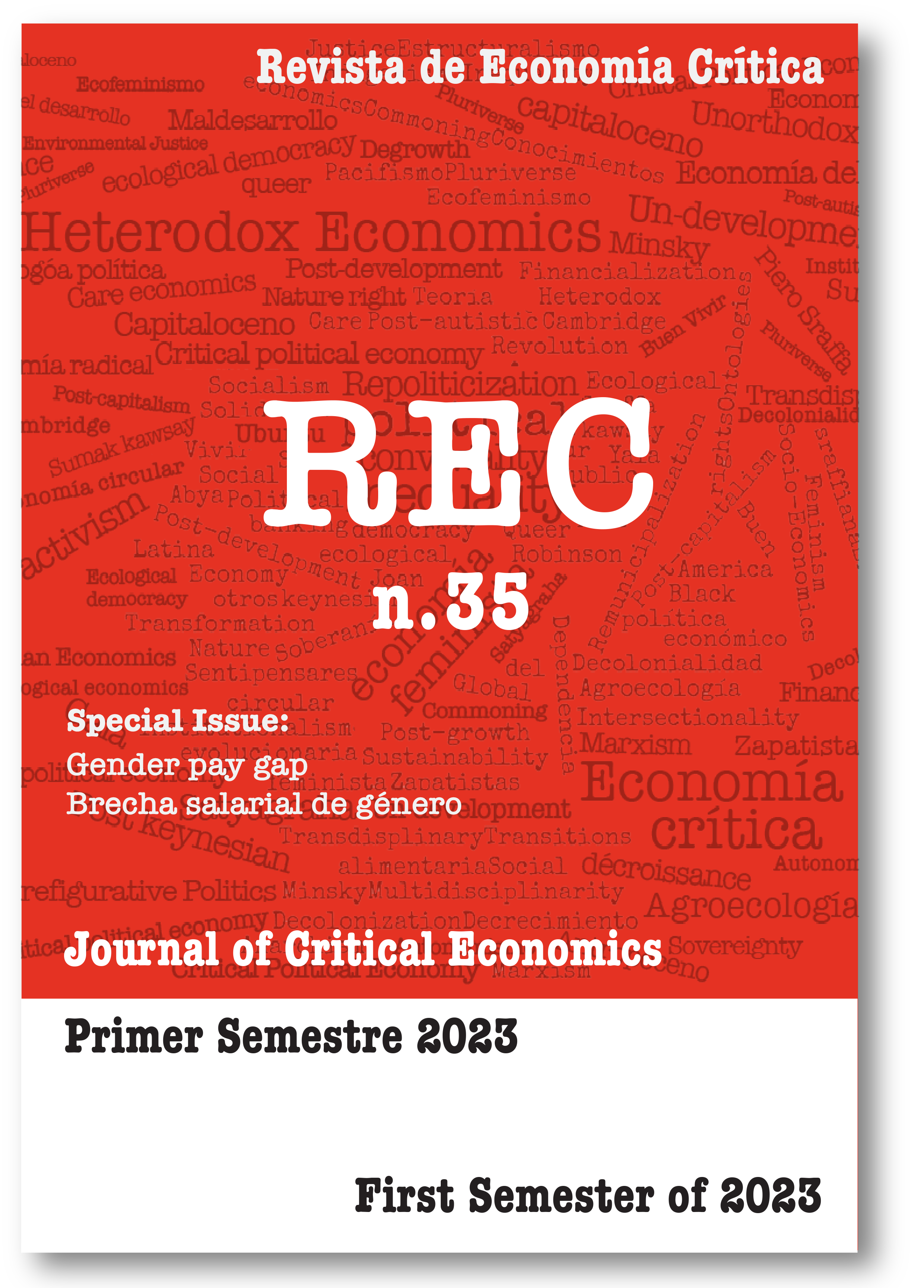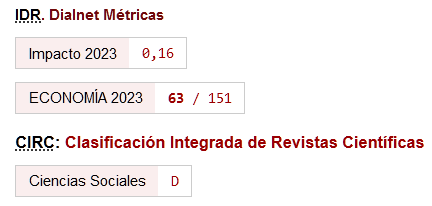The wage reality of women in the Spanish labour market
gaps, discrimination and divergent effects from the gender perspective
DOI:
https://doi.org/10.46661/rec.8968Keywords:
Labour market, Wage gap, Precariousness, Gender inequalitiesAbstract
The present work analyses the maintenance and magnitude that the gender wage gaps in the Spanish labour market reach, still today, in the 21st century, distinguishing between the distances that correspond to direct discriminatory practices on the part of the contracting entities from those others that are related to the unequal impact of the advance of precariousness on men and women. For this, a descriptive approach to the phenomenon and a separate analysis of both types of explanatory factors have been used in a sufficient period (2000-2021), in which expansive and recessive periods are contrasted, which allows us to demonstrate the structural nature of the phenomenon. of this problem in Spain, but also in the reference economies that make up the European Union. However, a deep understanding of wage inequality forces us to go beyond the sphere of the world of work and reflect on a broader scope, in which all the jobs that support economic activity and the living conditions of the population are considered. population, as well as the unequal participation and recognition that, from the gender perspective, determine the positional sense of women as workers, both inside and outside the labour market. A treatment in these terms makes it possible to have an accurate diagnosis of the problem to propose possible lines of action aimed at reducing and resolving the inherited economic inequalities that are still active.
Downloads
References
ACTRAV. (2011). Políticas y regulaciones para luchar contra el empleo precario. Ginebra: OIT.
Aláez, R., & Ullibarri, M. (2000). Discriminación salarial por sexo: un análisis del sector privado y sus diferencias regionales en España. España: ICE.
Aliaga, C. (2006). Statistics in Focus: Population and social conditions. How is the time of women and men distributed in Europe? EU Commission: Eurostat Statistics in focus 4/2006.
Alonso, N., Trillo, D., & Vicent, L. (2022). Análisis del sector de trabajo doméstico de las mujeres en la Unión Europea: enfoque conceptual y limitaciones estadísticas. Revista De Economía Mundial, (60), 151-171. https://doi.org/10.33776/rem.v0i60.5621 DOI: https://doi.org/10.33776/rem.v0i60.5621
Alonso, N., & Trillo, D. (2021). La crisis del estado de bienestar y sus repercusiones sobre la situación sociolaboral de las mujeres. Revista De Economía Crítica, 2(20), 135-154.
Baquero, J., Gómez, T. V., & Ruesga, S. M. (2019). Reflexionando sobre la brecha salarial de género. Revista De Derecho De La Seguridad Social, Laborum, (19), 265-274.
Balbo, L. (1994). La doble presencia. En C. Borderías, C. Carrasco, & C. Alemany (Eds.), Las mujeres y el trabajo. Rupturas conceptuales (pp. 503-513). Barcelona y Madrid: Fuhem-Icaria.
Benería, L., & Roldán, M. (1987). The crossroads of class & gender: industrial homework, subcontracting, and household dynamics in Mexico City. Chicago: University of Chicago Press.
Bieler, A., & Morton, A. D. (2021). Is capitalism structurally indifferent to gender?: Routes to a value theory of reproductive labour. Environment and Planning A: Economy and Space, 53(7), 1749-1769. https://doi.org/10.1177/0308518X211031572 DOI: https://doi.org/10.1177/0308518X211031572
Bosch, E., Ferrer, V. A., & Alzamora, A. (2006). El Laberinto Patriarcal. Madrid: Anthropos.
Browne, I., & Misra, J. (2003). The intersection of gender and race in the labor market. Annual review of sociology, 29(1), 487-513. https://doi.org/10.1146/annurev.soc.29.010202.100016 DOI: https://doi.org/10.1146/annurev.soc.29.010202.100016
Bundlender, D., & Brathaug, A. (2008). Cómo valorar el trabajo no remunerado. En Organización Panamericana de la Salud, La economía invisible y las desigualdades de género (pp. 59-86). Washington: OPS-CEPAL-CSIC.
Castaño, C. et al. (2009). Mujeres y poder empresarial en España. España: Instituto de la Mujer. Ministerio de Igualdad.
Carrasco, C. (1991). El Trabajo doméstico: un análisis económico. Colección Tesis Doctorales. Madrid: Ministerio de Trabajo y Seguridad social.
Carrasquer, P., Sánchez-Mira, N., López, M., & Recio, C. (2017). La Brecha salarial como indicador de las desigualdades de género en el mercado de trabajo. Una aproximación a las lógicas sectoriales y organizativas. XII Congreso Español de Sociología Grandes transformaciones sociales, nuevos desafíos para la sociología, Asturias. https://doi.org/10.5565/rev/aiet.56 DOI: https://doi.org/10.5565/rev/aiet.56
Cesaratto, S., & Stirati, A. (2010). Germany and the European and global crises. International Journal of Political Economy, 39(4), 56-86. https://doi.org/10.2753/IJP0891-1916390403 DOI: https://doi.org/10.2753/IJP0891-1916390403
Chancel, L. (Ed.). (2022). World inequality report 2022. Harvard: Harvard University Press. https://doi.org/10.4159/9780674276598 DOI: https://doi.org/10.4159/9780674276598
CNMV. (2021). Informe anual de Remuneraciones de los Consejeros de las sociedades cotizadas. España: Comisión Nacional del Mercado de Valores.
Cox, N., & Federici, S. (1975). Counter-planning from the Kitchen: Wages for Housework. Nueva York: New York Wages for Housework Committee and Falling Wall Press.
Díaz, C., & Simó, C. X. (Eds.). (2016). Brecha Salarial y Brecha de Cuidados. Valencia: Tirant lo Blanch.
Federici, S. (2021). Patriarchy of the Wage: Notes of Marx, Gender, and Feminism. Oakland, CA: PM Press.
Fraser, N., Gutiérrez, R., & Peña, R. (2011). Working Poverty in Europe. A Comparative Approach. Basingstoke: Palgrave Macmillan. https://doi.org/10.1057/9780230307599 DOI: https://doi.org/10.1057/9780230307599
Gálvez, L., & Rodríguez, P. (2013). El empleo de las mujeres en la España democrática y el impacto de la Gran recesión. Revista Internacional de Ciencias Sociales, 32, 105-123.
García Sainz, C. (2017). El impacto de la crisis económica en la pobreza de tiempo y la desigualdad de género. Arbor, 193(784), a382. https://doi.org/10.3989/arbor.2017.784n2005 DOI: https://doi.org/10.3989/arbor.2017.784n2005
Giammarioli, N., Messina, J., Steinberger, T., & Strozzi, C. (2002). European labor share dynamics: an institutional perspective. European University Institute, Working Paper ECO núm. 2002/13.
González, S., & Guillén, A. M. (2009). La calidad del empleo en la Unión Europea. Debate político y construcción de indicadores. Revista del Ministerio de Trabajo e Inmigración, núm. 81, 71-88.
Karamessini, M., & Rubery, J. (Eds.). (2013). Women and Austerity: The Economic Crisis and the Future for Gender Equality. Abingdon and New York: Routledge. https://doi.org/10.4324/9780203066294 DOI: https://doi.org/10.4324/9780203066294
Larrañaga, I., Arregi, B., & Arpal, J. (2004). El trabajo reproductivo o doméstico. Gaceta Sanitaria, núm. 18, supl. 1, 31-37. https://doi.org/10.1157/13062248 DOI: https://doi.org/10.1157/13062248
Longo, R., Lenta, M. M., & Zaldúa, G. (2019). Mujeres trabajadoras y participación social: problemáticas, iteraciones e innovaciones. Anuario de investigaciones, 26, 137-145.
Mazzei, C. (2013). Producción y Reproducción: la mujer y la división socio-sexual del trabajo. Rumbos TS, núm. 8, 128-142.
Pagán, R. (2007). Diferencias salariales entre el empleo a tiempo completo y parcial. Revista de Economía Aplicada, 15(43), 5-47.
Peet, R. (2011). Inequality, crisis and austerity in finance capitalism. Cambridge Journal of Regions, Economy and Society, 4(3), 383-399. https://doi.org/10.1093/cjres/rsr025 DOI: https://doi.org/10.1093/cjres/rsr025
Picchio, A. (Ed.). (2003). Unpaid Work and the Economy. Londres, Nueva York: Routledge.
Recio, A. (2010). Capitalismo español: La inevitable crisis de un modelo insostenible. Revista de Economía Crítica, núm. 9, 198-222.
Rubery, J. (2023). Austerity and the future for gender equality in Europe. ILR Review, 68(4), 715-741. https://doi.org/10.1177/0019793915588892 DOI: https://doi.org/10.1177/0019793915588892
Smart, B. (2019). An Unsustainable Modernity: democracy, the global climate emergency and environmental ethics. Journal ISSN, 1467, 0437. https://doi.org/10.31273/LGD.2019.2402 DOI: https://doi.org/10.31273/LGD.2019.2402
Smith, J. (2016). Imperialism in the twenty-first century: Globalization, super-exploitation, and capitalism's final crisis. New York: NYU press.
Stevano, S., Franz, T., Dafermos, Y., & Van Waeyenberge, E. (2021). COVID-19 and crises of capitalism: intensifying inequalities and global responses. Canadian Journal of Development Studies/Revue canadienne d'études du développement, 42(1-2), 1-17. https://doi.org/10.1080/02255189.2021.1892606 DOI: https://doi.org/10.1080/02255189.2021.1892606
United Nations. (2022). Closing gender pay gaps is more important than ever. UN News. Retrieved from. https://news.un.org/en/story/2022/09/1126901
Vicent, L. (2017). Precariedad laboral española. Una perspectiva de género. Tesis doctoral. Madrid: Universidad Complutense de Madrid.
World Economic Forum. (2022). The Global Gender Gap Index 2022. Insight Report, WEF.
Zugasti, N. (2014). Incidencia de la crisis en el empleo extranjero. Evidencias a partir de las transiciones laborales de trabajadores indefinidos. Revista de sociología, 99(2), 285-306. https://doi.org/10.5565/rev/papers.644 DOI: https://doi.org/10.5565/rev/papers.644
Downloads
Published
How to Cite
Issue
Section
License
Copyright (c) 2023 Lucía Vicent Valverde, David Trillo del Pozo, María Eugenia Ruiz-Gálvez

This work is licensed under a Creative Commons Attribution 4.0 International License.
This licence allows third parties to share (copy and redistribute the material in any medium or format) and adapt (remix, transform and create from the material for any purpose, including commercial purposes), provided that authorship and first publication in this journal (The Journal, DOI of the work) is acknowledged, a link to the licence is provided, and it is stated whether changes have been made to the work.







